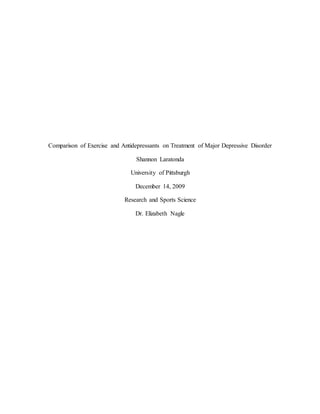
Comparison of Exercise and Antidepressants on Tx of MDD
- 1. Comparison of Exercise and Antidepressants on Treatment of Major Depressive Disorder Shannon Laratonda University of Pittsburgh December 14, 2009 Research and Sports Science Dr. Elizabeth Nagle
- 2. 2 Literature Review Depression is a major disorder that affects one’s well being. Depression is a common cause of morbidity and mortality worldwide (6). Studies to evaluate the association between exercise and depression are important in providing the option of having alternative ways of reducing their symptoms besides antidepressants. Research analyzing this association between exercise and depression included Menzyk et. al. who found physically active obese women had significantly better judgment concerning the looks of their faces, breasts, legs, and height compared to physically inactive ones. This suggests positive self-esteem effects level of depression (1). Smits et. al. found a positive effect and supports exercise prescription for treatment of anxiety sensitivity. This suggests that using exercise to reduce anxiety sensitivity leads to significant improvements in levels of anxiety and depressed mood (2). De Moor et. at. confirmed in a longitudinal study of twin adults that lower levels of regular exercise are associated with higher levels of anxious and depressive symptoms (3). Comparatively, Bartholomew et. al. investigated that a 30 minute bout of moderate-intensity aerobic exercise sufficiently improves mood and well-being in patients with major depressive disorder (4). Similar to previous studies, Blumenthal et. al. studied the efficacy of exercise in patients with major depressive disorder and found it to be generally comparable with patients receiving antidepressant medication (5). Medications often have an infinite number of unwanted and irritable side-effects causing a vicious cycle of being prescribed more and more to cover up other symptoms, putting individuals at risk for drug addiction. As an ideal treatment, exercise has minimal irritable side- effects such as muscle soreness and has many health benefits such as reducing risk of CVD and
- 3. 3 diabetes, decreasing emotional tension and external stresses, increasing self-esteem and counteracts depression. The purpose of this study is to show how exercise serves as a better treatment than antidepressants in patients diagnosed with major depressive disorder. Antidepressants can be very dangerous with severe side=effects and become addicting. A lifestyle containing regular physical activity and exercise is much healthier to become addicted to. Exercise has many other positive effects outside improvement of depression. Physical activity serves to reduce the risk of hypertension, diabetes, coronary heart disease, obesity, hyperglycemia, and other cardiovascular diseases as well as improving well-being. Ho: Exercise is not more beneficial than antidepressants in treating major depressive disorder.
- 4. 4 Methods I. Type of Research Design and Sample Size and Sampling Method a. 100 subjects diagnosed with major depressive disorder (MDD) recruited from institutions like Western Psychiatric Hospital, ages 18+, male and female b. 4 groups: exercise only; antidepressants only; exercise and antidepressants; and placebo serving as control group c. Test pre- and post- exercise/antidepressants after 6 month period using questionnaires and clinical interviews with a specified psychologist d. Subjects rights and privacy will be protected by HIPAA and informed consent will be obtained from each subject II. Methodology a. Screening of individuals will be done to eliminate subjects with any disorder on top of major depressive disorder (>1 disorder) b. Study will obtain approval by Dr. Elizabeth Nagle et. al. of University of Pittsburgh Research Review Board c. Group 1 and 3 will perform supervised 30 minutes of moderate-intensity aerobic exercise in Trees gym 4-5 times a week for 6 months (any convenient time) d. Group 2 and 3 will be prescribed monthly doses of antidepressants for 6 months e. Group 4 will receive placebo for 6 months f. All groups will receive interview and questionnaires 1 week before start of exercise and/or medication g. Human Subjects
- 5. 5 i. Following recruitment procedures, potential subjects would typically be contacted. This proposal serves strictly for the achievement of gained knowledge and experience with research among undergraduate students. The following proposal will not be submitted for publication. Confidentiality will be strictly enforced and data will not be collected. No portion of this proposal used publicly, therefore Human Subject Review is unnecessary. III. Statistical Analysis a. Independent variables: questionnaires and psychiatric interviews measuring severity of MDD b. Dependent variables: exercise, antidepressant, placebo c. SPSS to run descriptive statistics to compare groups: correlation between exercise and medication, z-scores, dependent T-test (pre- and post-) d. Any p value ≤.05 will be considered statistically significant and will result in rejection of null
- 6. 6 REFERNCES 1. Menzyk K, Cajdler A, Pokorski M. Influence of Physical Activity on Psychosomatic Health in Obese Women. Journal of Physiology and Pharmacology. 2008;6:441-448. 2. Smits AJ, Berry AC, Rosenfield D, Powers MB, Behar E, Otto MW. Reducing Anxiety Sensitivity with Exercise. Depression and Anxiety. 2008;25:689-699. 3. De Moor MH Boomsma DI, Stubbe JH, Willemsen G, DeGeus JC. Testing Causality in the Association Between Regular Exercise and Symptoms of Anxiety and Depression. Arch Gen Psychiatry. 2008;8:897-905. 4. Bartholomew JB, Morrison D, Ciccolo JT. Effects of acute exercise on mood and well-being in patients with major depressive disorder. Medicine & Science in Sports & Exercise. 2005;37:2032-2037. 5. Blumenthal JA, Babyak MA, Doraiswamy PM, Watkins L, Hoffman BM, Barbour KA, Herman S, Craighead WE, Brosse AL, Waugh R, Hinderliter A, and Sherwood A. Exercise and Pharmacotherapy in the Treatment of Major Depressive Disorder. Psychosomatic Medicine. 2007;69:587-596. 6. Mead GE, Morley W, Campbell P, Greig CA, McMurdo M, Lawlor DA. Exercise for depression. The Cochrane Collaboration. 2009;4.